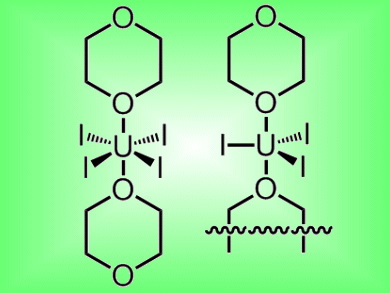In light of the situation at the Fukushima Daiichi power plant, Japan, many questions are being asked about the safety of nuclear power and nuclear power plants. One hurdle to the development of safer, advanced nuclear fuels is the difficulty in producing the uranium starting materials needed for research.
Jaqueline Kiplinger and colleagues, Los Alamos National Laboratory, USA, have reported a way to convert uranium metal into the precursors necessary for further development. The synthesis involves stirring metal uranium shavings in 1,4-dioxane and iodine at room temperature. This produces the stable complexes UI3(1,4-dioxane)1.5 or UI4(1,4-dioxane)2.
This route removes the need for toxic materials such as the chlorine-containing compounds or methyl iodide used in conventional methods. The authors hope that this easy, simple, and safe access to uranium precursors will enable future progress in uranium materials science and nuclear fuel cycle research.
- UI4(1,4-dioxane)2, [UCl4(1,4-dioxane)]2, and UI3(1,4-dioxane)1.5: Stable and Versatile Starting Materials for Low- and High-Valent Uranium Chemistry
M. J. Monreal, R. K. Thomson, T. Cantat, N. E. Travia, B. L. Scott, J. L. Kiplinger,
Organometallics 2011, 30(7), 2031–2038.
DOI: 10.1021/om200093q
► Also of interest:
- Magazine: Ideal Templates for Stable U28 Clusters
Understanding the chemistry of radioactive compounds emerges as one of the most urgent scientific challenges



